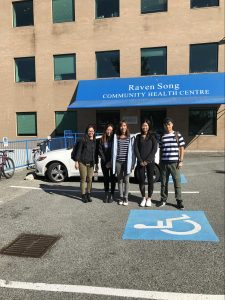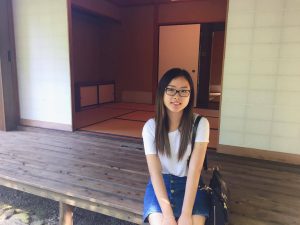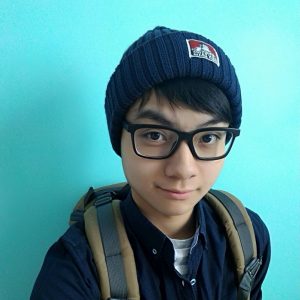VFAM 101: All the Basics You Need to Know
Who are we?
We are a group of UBC students brought together with the mission to venture outside of the classroom and contribute to our community.
Before we continue, let’s introduce our group members…

(left to right: Tina Li, Alison Chan, Sophia Liu, Hilary Kuo, and Sherman Lee)
About Us
Tina Li

Hello, my name is Tina and I’m a fourth-year Nutritional Sciences student at UBC. My interests lie in human nutrition, food security and environmental sustainability. I chose the Vancouver Asset Map project because I want to put my knowledge of food systems into real-world practice. Ultimately, I hope to make positive contributions towards addressing food accessibility for different neighbourhoods in Vancouver.
Alison Chan
 Hello! My name is Alison and I am currently in my 4th year of study at UBC, majoring in Food and Nutritional Sciences. I love eating and exploring the streets of Vancouver. As a student I am always in the search of good and affordable food, which is why I chose this project. It will be interesting for me to find out more about locations where people can access low cost meals while working on a food asset map. Prior to starting this project, I never knew what a food asset map is and did not know that such a useful tool was available to the public. I think this is a great opportunity for me to partner up with the community so I can learn while providing something useful for the people of Vancouver. In the past, I have had experience venturing out of the lecture hall to assess food security at a local high school as a part of LFS 250. Learning outside of a classroom was very different in a good way. I’m excited now that I have another opportunity to go out and work with a community partner this time!
Hello! My name is Alison and I am currently in my 4th year of study at UBC, majoring in Food and Nutritional Sciences. I love eating and exploring the streets of Vancouver. As a student I am always in the search of good and affordable food, which is why I chose this project. It will be interesting for me to find out more about locations where people can access low cost meals while working on a food asset map. Prior to starting this project, I never knew what a food asset map is and did not know that such a useful tool was available to the public. I think this is a great opportunity for me to partner up with the community so I can learn while providing something useful for the people of Vancouver. In the past, I have had experience venturing out of the lecture hall to assess food security at a local high school as a part of LFS 250. Learning outside of a classroom was very different in a good way. I’m excited now that I have another opportunity to go out and work with a community partner this time!
Sophia Liu

Hi, I am a third year student in UBC majoring in Food, Nutrition & Health. I love exploring different types of foods. I am interested in school food system and nutritional education in younger generations. However, I realized filling our stomaches comes first before considering the nutritional quality, which is why I chose this project since the food asset map will help people gain access to affordable food. I wish to apply food system knowledge while working with the community, and hopefully decrease their worries about “where and what to eat” everyday.
Hilary Kuo

Hello, I am a third year student at UBC studying Applied Biology. I am very interested in learning more about genetics and evolution of marine animals. I also love doing research on animal welfare and about how it relates to our society. Food plays an important role in our daily lives and having the ability to afford and consume healthy food is crucial. I chose this project because I want to help people facing challenges with food accessibility by increasing their food options. By updating the Vancouver Food Asset Map with convenience stores, I hope to allow the community to gain more access to food.
Sherman Lee
 Hi all, I am a third year student majoring in Global Resources Systems. Since my childhood I have been fascinated by the interactions and trade-offs between human and nature, thus the selection of my major. In my studies, I have specialized in the domain of freshwater resources. I feel that global freshwater issues are fundamentally similar to food related topics, as we biologically have a huge reliance on both freshwater and food resources. Through participating in the LFS 350 course projects, I hope to gain insight and experience in solving these issues. As an international student, there was a time when I had little knowledge on what food assets are located in the city. By contributing to the Vancouver Food Asset Map I hope that I can assist others that experienced the same situation as I did several years ago when I first arrived. I think this would provide great relief to those in need since having access to appropriate food provides incomparable warmth and comfort when you’re out alone in an unfamiliar place.
Hi all, I am a third year student majoring in Global Resources Systems. Since my childhood I have been fascinated by the interactions and trade-offs between human and nature, thus the selection of my major. In my studies, I have specialized in the domain of freshwater resources. I feel that global freshwater issues are fundamentally similar to food related topics, as we biologically have a huge reliance on both freshwater and food resources. Through participating in the LFS 350 course projects, I hope to gain insight and experience in solving these issues. As an international student, there was a time when I had little knowledge on what food assets are located in the city. By contributing to the Vancouver Food Asset Map I hope that I can assist others that experienced the same situation as I did several years ago when I first arrived. I think this would provide great relief to those in need since having access to appropriate food provides incomparable warmth and comfort when you’re out alone in an unfamiliar place.
Our Expectations
Our group shares an interest in accessible and affordable food, which is the reason why we chose the Vancouver Food Asset Map (VFAM) project. If you’re wondering what a food asset map is, it is a map showing what sort of food services, programs and other resources are available in an area. In addition to that, the food asset map will tell you details such as the hours and whether free or low cost meals are available at each marked location. Our goal for this project is to help address community food insecurity and acquire a healthy living status through getting access to different food sources using VFAM, as well as gaining practical experience working with community. Through this project, we want to gain a better understanding of where the affordable food is in Vancouver, we also want to deepen our understanding towards the needs of people who experience food insecurity, which will help us improve and promote this map to people in need.
About the Project
This project is an asset-based community development (ABCD) which practices community capacity building mentioned by McCullen et al. (2005). It is important to note that community capacity building in ABCD is different in nature compared to charities. While charities provide short term solutions, often times they can make people feel that they are unable to provide for themselves. On the other hand, community capacity building is about understanding the obstacles people face and helping them overcome those obstacles by strengthening their ability to sustain themselves.
Vancouver Coastal Health is one of the six health authorities in British Columbia that support healthy lives in healthy communities through care, education, and research. Its “People first” framework shapes the approach of vision, mission, values and goals, and enables it to develop various projects to provide outstanding services to public. VFAM, as one of the projects, brings forth the strengths, gaps and areas for improvement in local food systems. This term, we have partnered up with a public health dietitian, Kathy Romses, from Evergreen Community Health Center, to expand and update a pre-existing Vancouver food asset map with a focus on convenience stores. According to VFAM, a convenience store is defined as, “Stores that offer a limited choice of food items, often including snacks, soft drinks and other mostly processed products [that] sell a limited assortment of canned goods, produce, bread, egg and dairy products”. Stores that fall under this category include pharmacies, dollar stores and shops that sell items related to everyday needs. These stores should have at least 2 food groups from the Canada’s Food Guide available. By the addition of convenience stores in the food asset map, we hope to further support the community’s self-reliance.

Our First Impression
As a group, we valued the opportunity of becoming a part of the VFAM project. We wish to address food-related issues in Vancouver as well as promoting the available resources that can help the public to become self-reliant and capable of overcoming obstacles to food justice. After attending our first meeting with Kathy Romses, a Public Health Dietitian at Evergreen Community Health Centre, we received and gained a better understanding of what the project is and how we can approach it. During the meeting, Kathy had mentioned that many people who experience food insecurity are the working poor who has little time and access to private transportation, therefore, convenience is an important aspect to consider when attempting to assist them. As mentioned by Ernesto Sirolli (2012), the important thing about helping others is by listening to what the community truly needs, we wish that through our collaboration with the community partners will empower us to take actions in meeting the community needs and hopefully providing solutions for the existing issue of food insecurity in Vancouver. Using the Asset-based community development, we can assess the strengths and potentials of the current food accessibility and affordability in the community and integrate them into our VFAM project. We appreciated that health authorities have taken the initial step in recognizing the problem of food injustice and created the VFAM as a strategic tool to address food accessibility by “eliminating disparities and inequities” (Gottlieb & Joshi, 2010). We hope that by the end of this experience, the addition of convenience stores on the VFAM will provide more food options and enhance food justice in the local food system.
References:
Gottlieb, R., & Joshi, A. (2010). Food Justice. MIT Press.
McCullum, C., Desjardins, E., Kraak, V. I., Ladipo, P., & Costello, H. (2005). Evidence-based strategies to build community food security. Journal of the American Dietetic Association, 105(2), 278-283.
Sirolli, E. (2012). Ernesto Sirolli: Want to help someone? Shut up and listen! Retrieved from https://www.youtube.com/watch?v=chXsLtHqfdM
Vancouver Coastal Health. (2017). Vancouver Food Asset Map. Retrieved from http://www.vch.ca/public-health/nutrition/vancouver-food-asset-map
Vancouver Coastal Health. (2017). Strategy. Retrieved from http://www.vch.ca/about-us/strategy